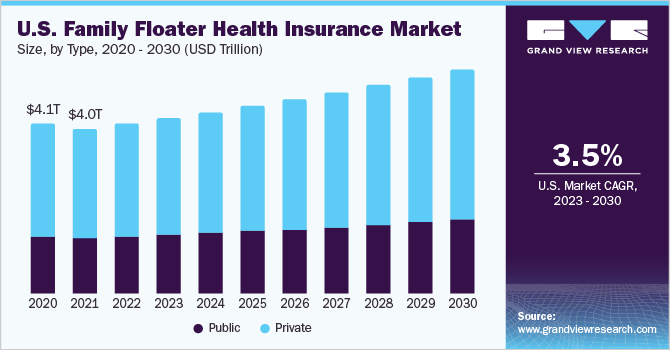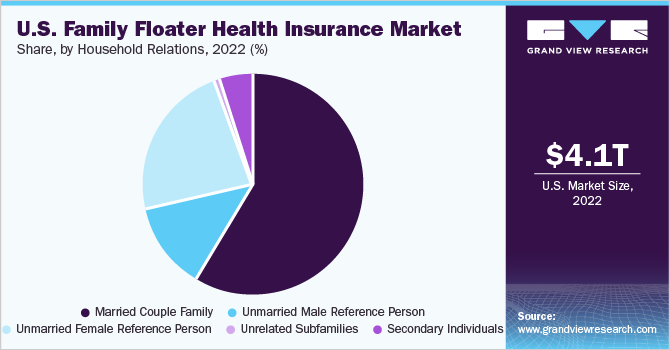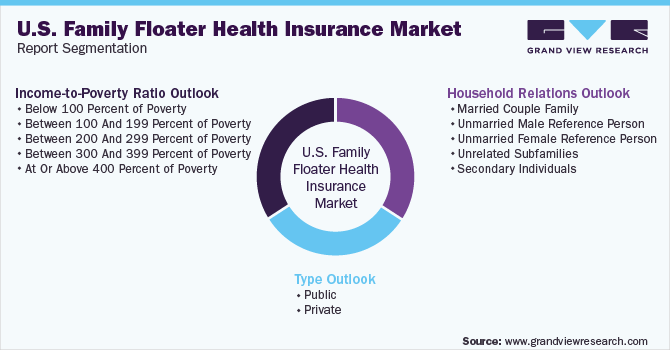- Home
- »
- Medical Devices
- »
-
U.S. Family Floater Health Insurance Market Size Report, 2030GVR Report cover
![U.S. Family Floater Health Insurance Market By Type (Public, Private), By Household Relations (Married Couple Family, Unmarried Female Reference Person), By Income-to-Poverty Ratio, By Region, And Segment Forecasts, 2023 - 2030Report]()
U.S. Family Floater Health Insurance Market By Type (Public, Private), By Household Relations (Married Couple Family, Unmarried Female Reference Person), By Income-to-Poverty Ratio, By Region, And Segment Forecasts, 2023 - 2030
- Report ID: GVR-4-68040-048-7
- Number of Report Pages: 120
- Format: PDF, Horizon Databook
- Historical Range: 2018 - 2021
- Forecast Period: 2023 - 2030
- Industry: Healthcare
Report Overview
The U.S. family floater health insurance market size was valued at USD 4.12 trillion in 2022 and is expected to expand at a compound annual growth rate (CAGR) of 3.54% from 2023 to 2030. The increasing cost of healthcare and rising awareness are among the major factors leading to the rising demand for health insurance. Moreover, the introduction of new products and technologies in the healthcare sector promoting the adoption of innovative procedures and marketing strategies by insurance providers to attract more customers are also driving the growth of the market. Another element fueling the expansion of the U.S. family floater market is the rising prevalence of chronic diseases. Financially, the treatment of chronic illnesses like cancer and heart disease can be very difficult for patients and their families. Hence, a lot of people choose health insurance to avoid the sudden stress of having to pay a large sum of money for hospitals and other medical bills.

The CDC estimates that individuals with chronic diseases and mental health disorders are responsible for 90% of the $3.8 trillion in annual healthcare costs in the country. The report also notes that a sizeable part of spending on public insurance goes toward treating chronic illnesses.
The COVID-19 pandemic had beneficial long-term impacts. Because it has made the necessity and significance of health insurance clear during the previous two years. The entire pandemic's short-term effects, however, were not so good for the health insurance sector. Public health measures during the early stages of the pandemic also had enormous financial effects.
Restaurants, office buildings, gyms, sports and entertainment venues, and other companies had to close due to the crisis. This led to an increase in the number of unemployed people in the nation, which in turn caused a decline in the number of people buying family health insurance floaters during the pandemic.
However, the fall in sales was a temporary impact and the industry recovered quickly post-pandemic. Individuals have understood the importance of health insurance now, more than ever. Thus, this is expected to drive the growth of the market over the forecast period.
Type Insights
According to type, the private segment dominated the market in 2022. This is because more people are choosing to purchase private insurance coverage to close the gap, cover ailments, and access services that are not covered by public health care. In the United States, private health insurance remained to be more common than public insurance, with 66.5% and 34.8%, respectively, according to the 2022 Census.
The public sector is also experiencing considerable expansion, even though the private sector will continue to rule the market and experience larger growth during the predicted period. Census 2022 estimates that in 2021, 7.9 percent of full-time, year-round workers received public health insurance, an increase of 1.8 percentage points from 2020. The number of year-round employees who work fewer than full-time hours and have public insurance rose by 1.6 percentage points to 22.6 percent over this time.
Household Relations Insights
In 2022, the married couples segment commanded the largest revenue share, due to a significant percentage of married couples implementing family floater insurance. Nonetheless, the number of married couple families is declining as a result of an increase in divorces and a move towards a big number of people opting to live alone. For instance, according to a news report, the proportion of the 130 million households in the U.S. with married parents and children under 18 declined from 18.6% in 2020 to 17.8% in 2021.

The unmarried female reference person held the second-highest market share in 2022 and is expected to witness maximum growth over the forecast period. This is because there is a significant rise in the number of single-parent families in the U.S., especially, single mothers. For instance, according to data from the U.S. Census Bureau for 2022, roughly 80 percent of the approximately 11 million single-parent families with children under the age of 18 were headed by single moms.
Income-to-Poverty Ratio Insights
At or above 400 percent of the poverty segment accounted for the highest market share in 2022. As income plays a very important role while purchasing health insurance. Individuals who are at or above 400 percent of poverty are most likely to have health insurance as compared to other lower-income segments.
The below 100 percent of poverty segment held the lowest share as this segment includes wage earners that lack health insurance coverage. This is a function of both the reduced likelihood that lower-waged jobs offer health benefits and the relatively costly premium, compared to income, paid by lower-income families to purchase employment-based coverage. For instance, just 31,683 families that fell into the below 100% poverty group got health insurance, according to census data from 2021. Nonetheless, 139,831 families with incomes at or over 400 percent of the poverty level had insurance, which is a significantly higher percentage than for other lower-income groups.
Regional Insights
The South region accounted for the highest market share in 2022 owing to the presence of noteworthy insurance plans and the substantial number of individuals with health insurance in the region.
Florida State dominated the South region in terms of revenue. This is due to the rising number of insured people in the state. For instance, according to the U.S. Department of Health and Human Services, insurance companies provided medical coverage through commercial healthcare plans in Florida to nearly 12.1 million people, as of June 30, 2022, over 62% of the 19.2 million insured in the state.
The West section held the second-highest revenue share in the U.S. family floater health insurance industry, in 2022. The state of California dominated this region due to high premium prices as compared to other states in the region.
Key Companies & Market Share Insights
As an attempt to broaden their presence and availability of products, key players in the market are focusing on carrying out various strategies such as partnerships and collaborations, the launch of new products, investment in local insurance companies, etc.
Companies in the insurance sector are also increasingly focused on mental well-being and are now developing products accordingly to help their customers get the needed treatment not only for physical illness but also to be mentally fit. For instance, in November 2021, Anthem revealed its new product called Behavioral Health Advantage. The new product will be offered in addition to Anthem’s standard behavioral health benefits and available to self-insured customers with less than 12,500 employees. Some prominent players in the U.S. family floater health insurance market include:
-
Cigna
-
Bupa
-
Now Health International
-
Blue Cross Blue Shield Association
-
Kaiser Foundation Grp
-
Anthem, Inc. (Now Elevance Health)
-
The IHC Group
-
Health Partners Group Ltd
-
Aviva
-
Providence Health Plan
-
Harvard Pilgrim Health Care, Inc.
U.S. Family Floater Health Insurance Market Report Scope
Report Attribute
Details
Revenue forecast in 2030
USD 5.43 trillion
Growth Rate
CAGR of 3.54% from 2023 to 2030
Base year for estimation
2022
Historical data
2018 - 2021
Forecast period
2023 - 2030
Quantitative units
Revenue in USD billion and CAGR from 2022 to 2030
Report coverage
Revenue forecast, company ranking, competitive landscape, growth factors, and trends
Segments covered
Type, household relations, income-to-poverty ratio, region
Regional scope
Northeast; Midwest; South; West
State scope
50 U.S. states excluding the District of Columbia & Puerto Rico
Key companies profiled
Cigna; Bupa; Now Health International; Blue Cross Blue Shield Association; Kaiser Foundation Grp; Anthem, Inc. (Now Elevance Health); The IHC Group; Health Partners Group Ltd.; Aviva; Providence Health Plan; Harvard Pilgrim Health Care, Inc.
Customization scope
Free report customization (equivalent up to 8 analyst’s working days) with purchase. Addition or alteration to country, regional & segment scope
Pricing and purchase options
Avail customized purchase options to meet your exact research needs. Explore purchase options
U.S. Family Floater Health Insurance Market Report Segmentation
This report forecasts revenue growth at the country level and provides an analysis of the latest industry trends in each of the sub-segments from 2018 to 2030. For this study, Grand View Research has segmented the U.S. family floater health insurance market report based on type, household relations, income-to-poverty ratio, and region:

-
Type Outlook (Revenue, USD Billion, 2018 - 2030)
-
Public
-
Private
-
-
Household Relations Outlook (Revenue, USD Billion, 2018 - 2030)
-
Married Couple Family
-
Unmarried Male Reference Person
-
Unmarried Female Reference Person
-
Unrelated Subfamilies
-
Secondary Individuals
-
-
Income-to-Poverty Ratio Outlook (Revenue, USD Billion, 2018 - 2030)
-
Below 100 Percent of Poverty
-
Between 100 And 199 Percent of Poverty
-
Between 200 And 299 Percent of Poverty
-
Between 300 And 399 Percent of Poverty
-
At Or Above 400 Percent of Poverty
-
-
Regional Outlook (Revenue, USD Billion, 2018 - 2030)
-
U.S
-
Northeast
-
Connecticut
-
Massachusetts
-
Pennsylvania
-
New Jersey
-
New York
-
Others
-
New Hampshire
-
Rhode Island
-
Vermont
-
Maine
-
-
Midwest
-
Illinois
-
Indiana
-
Michigan
-
Ohio
-
Wisconsin
-
Iowa
-
Kansas
-
Minnesota
-
Missouri
-
Nebraska
-
Others
-
North Dakota
-
South Dakota
-
-
West Group
-
Arizona
-
Colorado
-
Nevada
-
Utah
-
California
-
Oregon
-
Washington
-
Others
-
Idaho
-
Montana
-
New Mexico
-
Wyoming
-
Alaska
-
Hawaii
-
-
South
-
Florida
-
Georgia
-
Maryland
-
North Carolina
-
South Carolina
-
Virginia
-
Alabama
-
Kentucky
-
Tennessee
-
Louisiana
-
Oklahoma
-
Texas
-
Others
-
Delaware
-
West Virginia
-
Mississippi
-
Arkansas
-
-
-
Frequently Asked Questions About This Report
b. Some key players operating in the U.S. family floater health insurance market include Cigna, Bupa, Now Health International, Blue Cross Blue Shield Association, KAISER FOUNDATION GRP, ANTHEM, INC. (NOW ELEVANCE HEALTH), THE IHC GROUP, HEALTH PARTNERS GROUP LTD, Aviva, PROVIDENCE HEALTH PLAN, HARVARD PILGRIM HEALTH CARE, INC.
b. The U.S. family floater health insurance market size was estimated at USD 4.12 trillion in 2022 and is expected to reach USD 5,261.3 billion in 2023.
b. South region dominated the U.S. family floater health insurance market with a share of 37.4% in 2022. This is attributable to the presence of noteworthy insurance plans and the substantial number of individuals with health insurance in the region.
b. The U.S. family floater health insurance market is expected to grow at a compound annual growth rate of 3.5% from 2023 to 2030 to reach USD 5.43 trillion by 2030.
b. Key factors that are driving the U.S. family floater health insurance includes introduction of new products, technologies in the healthcare sector that is promoting the adoption of innovative procedures and marketing strategies by insurance providers in the market.
Share this report with your colleague or friend.
![gvr icn]()
NEED A CUSTOM REPORT?
We can customize every report - free of charge - including purchasing stand-alone sections or country-level reports, as well as offer affordable discounts for start-ups & universities. Contact us now
![Certified Icon]()
We are GDPR and CCPA compliant! Your transaction & personal information is safe and secure. For more details, please read our privacy policy.
We are committed towards customer satisfaction, and quality service.
"The quality of research they have done for us has been excellent."





